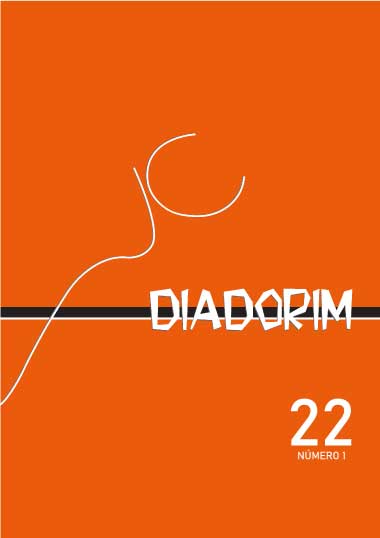Learning poverty among the primary pupils: a case study of native (Telugu) and english medium schools of Andhra Pradesh
DOI:
https://doi.org/10.35520/diadorim.2020.v22n1a32657Palavras-chave:
Learning Poverty, Reading and Comprehension, Native Medium, English Medium and School Children.Resumo
Learning poverty is one of the major issue lasting for many decades in India in general and Andhra Pradesh in particular. According to the World Bank in collaboration with UNESCO, learning poverty is an inability in reading and comprehending or understanding a simple story or paragraph in the respective languages. It is applicable to both disciplines i.e. either in humanities as well as in mathematics and sciences. This inability is found especially among the students aged between 5-10 (at the end of the primary school). In the present paper, it is highlighted that what are the driving forces for this learning poverty, what remedies can be taken into consideration to curb the learning poverty. In addition, the paper also intends to see whether the learning poverty exists in native (Telugu) medium school children or English medium school children. Is learning poverty confined to age groups between 5-10 or is it also found between the ages 10-15. Finally, the paper draws the conclusions based on the data and its results.
Referências
FAILING Schools: With poor quality of learning, Indian students aren’t being equipped for jobs of the future. Retrieved from https://timesofindia.indiatimes.com/blogs/talkingturkey/failing-schools-with-poor-quality-of-learning-indian-students-arent-being-equipped-for-jobs-of-the-future/
HARBERT, W., et al. Language and Poverty. Bristol: Multilingual Matters, 2009.
http://digitalcommons.iwu.edu/parkplace/vol14/iss1/16
INDIA’S students have poor learning levels. Can foundational education help them? Retrieved from https://www.hindustantimes.com/analysis/india-s-students-have-poor-learning-levels-can-foundational-education-help-them/story-7g7N9eCXPBzh3lFWjTAaRO.html
INGRUM, A. High School Dropout Determinants: The Effect of Poverty and Learning Disabilities, The Park Place Economist, Vol.14, 2006.
MILNER, R. H. Analyzing Poverty, Learning and Teaching through a Critical Race Theory Lens, Research Review in Education, Vol.37:1: 1-53, 2013.
MINISTRY of Human Resources Development, 2019. Draft National Educational Policy 2019. MHRD, Government of India.
MORENO-DODSON, B. (ed.). Reducing Poverty on a Global Scale: Learning and Innovative Development. Washington, DC: World Bank, 2005.
READ it right: Fix learning poverty to tackle actual poverty. Retrieved from https://timesofindia.indiatimes.com/blogs/toi-editorials/read-it-right-fix-learning-poverty-to-tackle-actual-poverty/
SABATES, R. The Impact of Lifelong Learning on Poverty Reduction. IFEL. Vol.1. England and Wales: National Institute of Adult Continuing Education, 2008.
SCHOOL Education. AP State Portal. Retrieved on 14th June, 2019. Retrieved from: https://en.wikipedia.org/wiki/Education_in_Andhra_Pradesh.
SEVENTH all India School Education Survey. National Tables
On Schools, Physical And Ancillary Facilities. Retrieved from http://www.ncert.nic.in/programmes/education_survey/pdfs/Schools_Physical_Ancillary_Facilities.pdf.
SINGH, B. D. R. M. Life Skills in India: An overview of evidence and current practices in our Current Education System. New Delhi: Central Square Foundation., 2015.
SKUTNABB-KANGAS, T. Bilingualism or Not: The Education of Minorities. Bristol: Multilingual Matters, 1981.
WAPULA, R.; CHAWAWA, M. Lifelong Learning for Poverty Eradication. Singapore: Springer, 2015.
WILLIAMS, F. (ed.). Language and Poverty: Perspectives on a Theme. New York: Academic Press, 1970.
Downloads
Publicado
Edição
Seção
Licença
Transferência de direitos autorais - Autorização para publicação
Caso o artigo submetido seja aprovado para publicação, já fica acordado que o autor autoriza a UFRJ a reproduzi-lo e publicá-lo na Diadorim: Revista de Estudos Linguísticos e Literários, entendendo-se os termos "reprodução" e "publicação" conforme definição respectivamente dos incisos VI e I do artigo 5° da Lei 9610/98. O artigo poderá ser acessado pela internet, a título gratuito, para consulta e reprodução de exemplar do artigo para uso próprio de quem a consulta. Essa autorização de publicação não tem limitação de tempo, ficando a UFRJ responsável pela manutenção da identificação do autor do artigo.

A Revista Diadorim utiliza uma Licença Creative Commons Atribuição-NãoComercial 4.0 Internacional (CC BY-NC 4.0).

